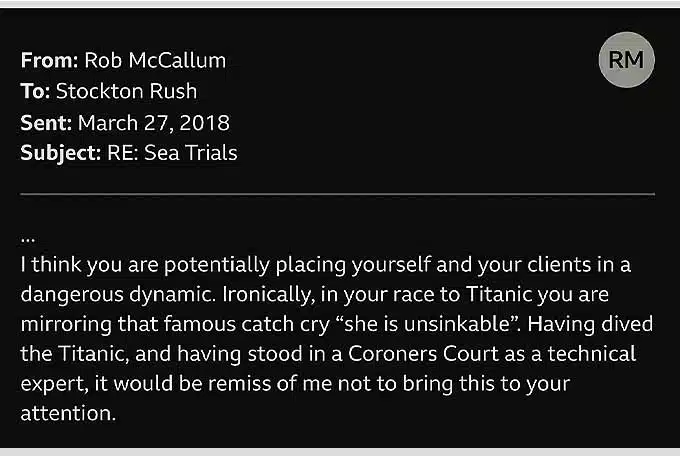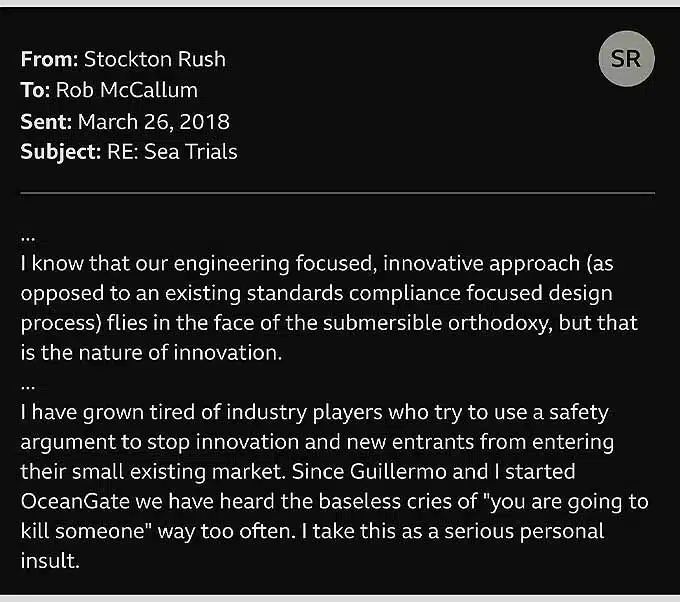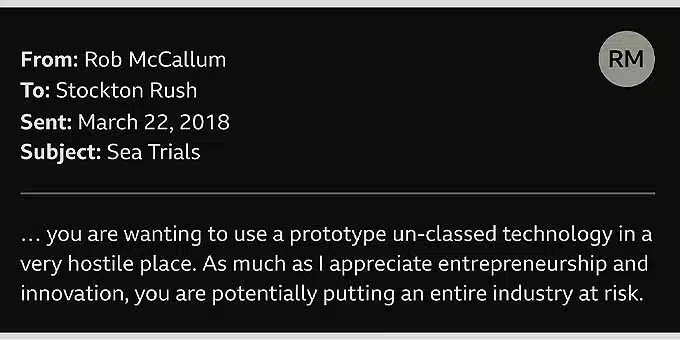
ĐẢM BẢO KIỂM TRA THỰC TẾ
Nghiêng chính trị
& Giai điệu cảm xúc
The article is politically unbiased, focusing on the factual reporting of a disaster and the preceding events.
Được tạo ra bằng trí tuệ nhân tạo.
The emotional tone is negative, highlighting a tragedy and the disregard for safety warnings that led to it.
Được tạo ra bằng trí tuệ nhân tạo.
Cập nhật:
Đọc
| Bởi Richard Aotta - In the aftermath of the Titan submersible disaster, emails reveal the OceanGate CEO was told, “In your race to Titanic you are mirroring that famous catch cry ‘she is unsinkable.’”
CEO Stockton Rush seemed to ignore a blaring siren from deep sea exploration specialist Rob McCallum telling him to stop using the sub until it had been properly classified.
Rob McCallum wrote to Rush in 2018, cautioning him about the safety of the Titan submersible, saying, “you are placing yourself and your clients in a dangerous dynamic.”
Nhưng đây là người khởi xướng:

Stockton Rush dismissed the safety concerns as an attempt to stifle innovation. “I’m tired of industry players who try to use a safety argument to stop innovation,” he retorted.
“We have heard the baseless cries of ‘you are going to kill someone’ way too often. I take this as a serious personal insult.”
Trong tạp chí email chain, McCallum likened Rush’s determination to launch the submersible to the Titanic’s ill-fated voyage, saying that ironically he was repeating history by adopting the famous “She is unsinkable” attitude.
McCallum’s repeated pleas for caution were brushed aside despite his expertise, and the Titan submersible was never certified.
Rush responded with frustration. He defended his innovation-driven approach and dismissed McCallum’s warnings as baseless. OceanGate lawyers then reportedly threatened pháp lý action, ending any further dialogue.
Five years later, McCallum’s warning came to fruition:

Fast forward to today, and the Titan suffered what officials believe was a “catastrophic implosion.” Among the fatalities were Stockton Rush himself and four others, including a 19-year-old business student Suleman Dawood.
The loss of lives is tragic, but the implications for the entire deep-sea exploration industry are monumental. McCallum urged Rush to be “very, very conservative” as his actions could put the whole industry at risk.
“Having dived the Titanic, and having stood in a Coroners Court as a technical expert, it would be remiss of me not to bring this to your attention.”
While Rush viewed the criticism as an attack on innovation, McCallum saw it as essential due diligence. Rush believed his engineering-focused approach was challenging the status quo, while McCallum stressed that sea trials and certification were crucial for safety.
Both men were passionate — one about pushing boundaries — the other about ensuring safety.

Stockton Rush founded OceanGate in 2009 with a vision of deep-sea travel. For $250,000, clients could journey to places like the Titanic wreck aboard the Titan sub.
The death toll increases…
When the Titanic sank on 15 April 1912 after striking an iceberg on its maiden voyage, it claimed the lives of 1,517 — that number has risen to 1,522.
Ultimately, hitting the iceberg was what sank the Titanic, but investigators found that the builders had cut costs during construction. Material scientists who analyzed rivets from the wreck found they were subpar, containing a high concentration of “xỉ,” a by-product of metal smelting, and if not removed, can cause the metal to split apart easily.
More than 3 million rivets holding the Titanic’s steel hull together were unfit for use and likely weakened the part of the ship that hit the iceberg, causing the hull plates to split apart on impact.
Both tragedies serve as a reminder that, in the depths of the ocean, the margin for error is as thin as a razor’s edge. Once again, history has taught us that cutting corners and trimming costs can have disastrous consequences.
As of now, OceanGate has not commented on the email exchanges.
Tham gia thảo luận!